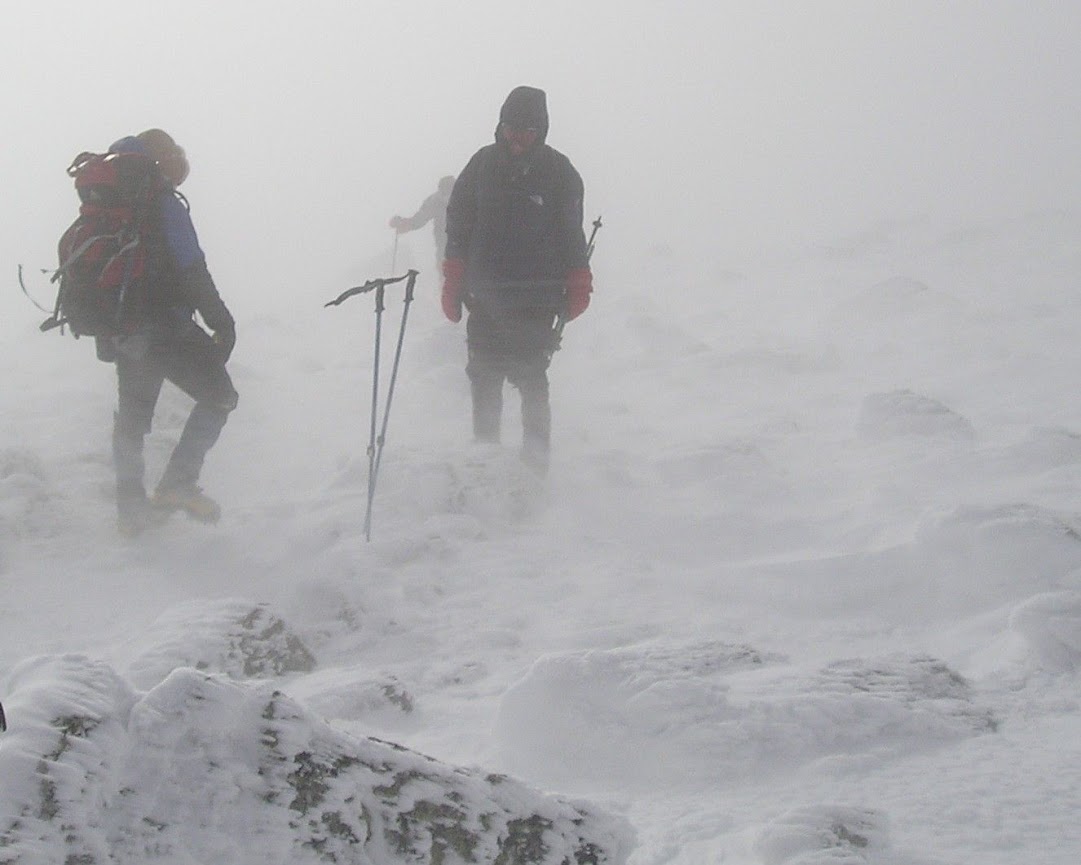The answer for me, in general, is meticulous planning ahead of time (I've never gone above treeline expecting anything other than whiteout conditions) and a high level of competence navigating by compass.
Here's one example: Day two of a Presi-traverse backpack three winters ago, coming down Washington to Lakes then on to Monroe. Heavy wind, cold, poor visibility, freezing fog/blowing snow. Getting to Crawford path from the summit of Washington is actually sort of a hassle (start out going northwest, then turn west, then southwest, but don't miss a trail junction!) With the conditions being what they were, we took a bearing directly on Lakes from the summit of Washington rather than trying to find the start of the trail, figuring we'd likely run into Crawford path anyway before we got to Lakes. This worked, and we picked up Crawford path after losing several hundred feet of elevation. But perhaps 1/2 mile or so from Lakes the snow was deep enough and visibility poor enough that we could no longer follow the trail. We knew quite precisely where we were (had been following our progress very closely on our map), so we took another bearing on Lakes and headed in that direction. Visibility was bad enough that we were tripping over snow drifts because we couldn't see them and occasionally sliding down steep drifts because we couldn't see those either. It really, truly is possible to walk directly off a cliff if visibility is bad enough. But we knew we weren't in the vicinity of any cliffs or serious drop offs. We got to the spot where we thought Lakes 'should' be, and there was in fact a 'lake,' just not 'Lakes." But after backtracking and wandering around a bit, we finally found the hut, though not until we were basically right on top of it. We stood in the lee and gathered ourselves to decide what we wanted to do next. We weren't particularly gripped, these conditions come with the territory, and we'd all been in that territory before; plus, we had full overnight gear and plenty of bailout options. So after taking some food and water we headed off for Monroe on a compass bearing. But the wind got a little worse, and midway up Monroe we just could not go on, so we turned around and fought bitterly through the wind, which had been at our right shoulder but was now directly in our left eye. We re-gathered in the lee of Lakes. The temp was predicted to drop further (it was 10 below at the time) and the wind to pick up (it was already heavy), so we decided it was time to bail. Once again, we took a bearing on the first 1/2 mile or so of Ammo Ravine and headed off. It wasn't terribly difficult to find the right drainage with a good compass bearing, but there were few cairns or anything else to guide us until we were into the woods. In spite of our relative confidence, it was a great relief to get out of the wind and whiteout - visibility improved markedly just a few hundred feet below Lakes, and the wind all but died. So, naturally, we began to question our decision to bail...

We were lucky enough to hitch a ride back to our cars from the Cog base station and headed off to the Moat. When we got out of the car, we could see a snow plume coming off the Presidentials, and the wind, even from that low altitude, was roaring! I do not on any level regret our decision to bail. We ate well. A couple of days later I realized that the underside of one of my nostrils had been exposed to the wind (through my balaclava and up the nose slot in my face mask) and I had a somewhat painful frost nip that took a couple of weeks to heal. I was reminded each time I blew my nose.
The keys to the success of this trip (a successful bailout - is that an oxymoron? Nah...), I think, were having full overnight gear so that, in the absolute worst case, we could drag an injured party member off the ridge, dig in, and camp quite comfortably for several days if necessary. We knew all of our bailouts. We had full confidence in our ability to navigate by compass. We had all experienced bad conditions in the past. These factors allowed us to keep our heads and think quite clearly and rationally, even when the conditions were pretty bad.

